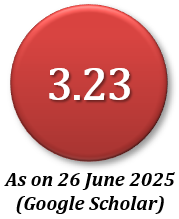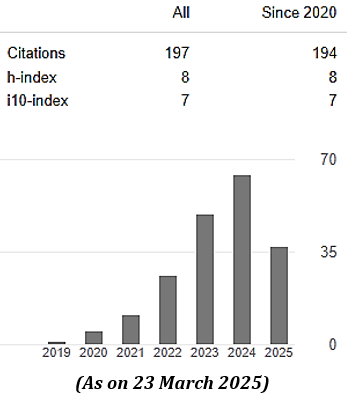Experimental Analysis on Safety System of a Simulated Small Scale Pressurized Water Reactor System with Intelligent Control
Abstract
Reactors are widely used in the nuclear power plant due to the rapid demand for electricity by reducing the greenhouse effect. However, the effectiveness of the nuclear reactor depends on an adequate safety system. Hence, temperature and heat transfer are two critical parameters for any reactor in operation for which intelligent temperature control with an integrated safety system is essential. Therefore, the present study has emphasized the development of a simulated small-scale water-based reactor with intelligent control and safety system and examined through the analysis of thermal-hydraulic parameters. Radial heat transfer of an electric rod used as fuel in the primary circuit has been analyzed by taking sensor reading in various positions of the core. The developed system is self-controlled with all possible active and passive safety systems. Consecutively, the prototype has also been designed including manual adjustment to ensure a fail-safe environment. The system is capable to operate at temperatures between 80°C and 120°C, although the design can withstand up to 200°C. The data of the experiment are taken under the pressure of 200 kPa at 120°C temperature. Results show that heat output of 2116.09 kJ has been obtained from the system against heat input of 2514.80 kJ, which gives an efficiency around 16% of the developed system.
Downloads
References
Balonov, M. (2013). The Chernobyl Accident as a Source of New Radiological Knowledge: Implications for Fukushima Rehabilitation and Research Programmes. Journal of Radiological Protection, 33, 27-40.
Breeze, P. (2014). Nuclear power Generation Technologies, Newnes Publication. 3rd Edition, Elsevier Ltd.
Gharib, M., Yaghooti, A. & Buygi, M. O. (2011). Efficiency Upgrade in PWRs, Energy and Power Engineering, 3, 533-536.
Ho, M., Obbard, E., Burr, P. A. & Yeoh, G. (2019). A Review on the Development of Nuclear Power Reactors, Energy Procedia, 160, 459-466.
Hossain, A., Islam, S., Hossain, T, Salahuddin, A. Z. M & Sarkar, A. R. (2019). An Intelligent Approach for Thermal-Hydraulic Studies on Safety and Efficiency of Nuclear Power Plant. Energy Procedia, 160, 436-442.
IAEA (2002). Accident Analysis for Nuclear Power Plants. IAEA Safety Reports Series No. 23, IAEA, Vienna.
IAEA (2019). Energy, Electricity and Nuclear Power Estimates for the Period up to 2050. IAEA Reference Data Series No. 1. 2019 Edition, IAEA, Vienna.
Ioka, I., Yonekawa, M., Miwa, Y., Mimura, H., Tsuji, H. & Hoshiya, T. (2000). Effect of Helium to dpa Ratio on Fatigue Behavior of Austenitic Stainless Steel Irradiated to 2 dpa, Journal of Nuclear Materials, 283-287, 440-445.
Khan, A. H., & Islam, M. S. (2019). Prediction of thermal efficiency loss in nuclear power plants due to weather conditions in tropical region, Energy Procedia, 160, 84-91.
Khan, A. H., Hasan, S. & Sarkar, M. A. R. (2018). Analysis of Possible Causes of Fukushima Disaster, International Journal of Nuclear and Quantum Engineering, 12(2), 53-58.
Kim, J. S., Park, S. Y. & Lee, D. H. (2019). Changes and Prospects of Safety Regulation Activities in Korean Nuclear Safety Research, International Journal of Innovative Technology and Exploring Engineering, 8(852), 777-783.
Kojima, T. & Sato, Y. (2007). Variations of a Passive Safety Containment for a BWR with Active and Passive Safety Systems, Journal of Nuclear Engineering and Design, 237, 74-86.
Miller, K. L. (1994). The Nuclear Reactor Accident at Three Mile Island, Radiographics, 14(1), 215-224.
Nain, H. M. Z., Islam, M. S. & Khan, A. H. (2019). A Study on Thermal-Hydraulics Characteristics for Designing a Shell and Tube Condenser for a 1200 MWe Nuclear Power Plant. J. Bangladesh Acad. Sci. 43(2), 181-189.
P´al, L. & P´azsit, I. (2009). The Fast Fission Factor Revisited. Nuclear Science and Engineering, 161(1), 111-118.
Patnaikuni, D. R. P. (2017). A Comparative Study of Arduino Raspberry Pi and ESP8266 as IoT Development Board. International Journal of Advanced Research in Computer Science, 8(5), 2350-2352.
Rahman, M. M., Akond, M. A. R., Basher, M. K., & Huda, M. Q. (2014). Steady-State Thermal-Hydraulic Analysis of TRIGA Research Reactor, World Journal of Nuclear Science and Technology, 4, 81-87.
Sunday, J. I., Daniel, R. E., & Okibe, A. E. (2013). Simulation of Safety and Transient Analysis of a Pressurized Water Reactor using the Personal Computer Transient Analyzer, Leonardo Electronic Journal of Practices and Technology, 22, 93-105.
Vojackova, J., Novotny, F. & Katovsky, K. (2017). Safety Analyses of Reactor VVER 1000, Energy Procedia, 127, 352-359.
Wheatley, S. Sovacool, B. K. & Sornette, D. (2016). Reassessing the Safety of Nuclear Power. Energy Research & Social Science, 206, 1-5.
Zhen, Y. Q. (2016). Safety and Effective Developing Nuclear Power to Realize Green and Low-carbon Development. Advances in Climate Change Research, 7(1–2), 10-16.
MIJST follows the open access policy.

This work is licensed under a Creative Commons Attribution-NonCommercial 4.0 International License. This allows anyone to copy, share, distribute, and modify the work for non-commercial purposes, where the original work and source should be properly credited.
















